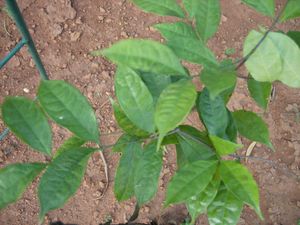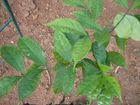Note: This is a project under development. The articles on this wiki are just being initiated and broadly incomplete. You can Help creating new pages.
Salacia reticulata - Meharimula
Meharimula is an indigenous flowering plant of the genus Salacia grown in dry zone forests in Sri Lanka. Meharimula or Kothala Himbutu is an indigenous Sri Lankan medicinal plant, but also grown in some parts of Southern India.
Contents
- 1 Uses
- 2 Parts Used
- 3 Chemical Composition
- 4 Common names
- 5 Properties
- 6 Habit
- 7 Identification
- 8 List of Ayurvedic medicine in which the herb is used
- 9 Where to get the saplings
- 10 Mode of Propagation
- 11 How to plant/cultivate
- 12 Commonly seen growing in areas
- 13 Photo Gallery
- 14 References
- 15 External Links
Uses
diabetes, salacia, gonorrhea, asthma, itchiness, joint pain, obesity, Excess thirst, menstrual problems
Parts Used
Chemical Composition
3-oxofriedelane, 3β-hydroxyfriedelane, β-sitosterol, 28-hydroxy-3-oxofriedelane and dulcitol were isolated from extracts of leaves as well as branches of S. elliptica. β-stearyloxy-olean-12-en, gutta-percha, 3,4-seco-friedelan-3-oic acid, palmitic acid, β-sistosterol glucoside, ethyl glucopyranoside [1]
Common names
| Language | Common name |
|---|---|
| Kannada | |
| Hindi | |
| Malayalam | |
| Tamil | kadalainjil, ponkoranti |
| Telugu | |
| Marathi | NA |
| Gujarathi | NA |
| Punjabi | NA |
| Kashmiri | NA |
| Sanskrit | |
| English | Oblong Leaf Salacia |
Properties
Reference: Dravya - Substance, Rasa - Taste, Guna - Qualities, Veerya - Potency, Vipaka - Post-digesion effect, Karma - Pharmacological activity, Prabhava - Therepeutics.
Dravya
Rasa
Tikta (Bitter), Kashaya (Astringent)
Guna
Laghu (Light), Ruksha (Dry), Tikshna (Sharp)
Veerya
Ushna (Hot)
Vipaka
Katu (Pungent)
Karma
Kapha, Pitta
Prabhava
Habit
Identification
Leaf
| Kind | Shape | Feature |
|---|---|---|
| Simple | elliptic – oblong | Leaves opposite, 6-12 x 3-6 cm, base acute, apex abruptly acuminate |
Flower
| Type | Size | Color and composition | Stamen | More information |
|---|---|---|---|---|
| Bisexual | 3-6 cm across | Greenish white or greenish yellow | 5-20 | Flowers Season is June - August |
Fruit
| Type | Size | Mass | Appearance | Seeds | More information |
|---|---|---|---|---|---|
| General | 7–10 mm | clearly grooved lengthwise, Lowest hooked hairs aligned towards crown | 1-4 | {{{6}}} |
Other features
List of Ayurvedic medicine in which the herb is used
Where to get the saplings
Mode of Propagation
How to plant/cultivate
Easily grown in most soils, preferring a calcareous soil. Thrives in a dry lightly shaded position, though it prefers full sun.Plants usually self-sow quite freely when growing in a suitable position. The seeds are contained in burrs that can easily attach themselves to clothing or animal's fur, thus transporting them to a new area where they can germinate and grow.The cultivar 'Sweet scented' is popular in France for making tea because the whole plant is sweet scented and the flowers have a spicy apricot-like fragrance[3]
Commonly seen growing in areas
Photo Gallery
References
External Links
- Ayurvedic Herbs known to be helpful to treat diabetes
- Ayurvedic Herbs known to be helpful to treat salacia
- Ayurvedic Herbs known to be helpful to treat gonorrhea
- Ayurvedic Herbs known to be helpful to treat asthma
- Ayurvedic Herbs known to be helpful to treat itchiness
- Ayurvedic Herbs known to be helpful to treat joint pain
- Ayurvedic Herbs known to be helpful to treat obesity
- Ayurvedic Herbs known to be helpful to treat Excess thirst
- Ayurvedic Herbs known to be helpful to treat menstrual problems
- Herbs with Roots used in medicine
- Herbs with common name in Tamil
- Herbs with common name in English
- Habit - Herb
- Index of Plants which can be propagated by Seeds
- Index of Plants which can be propagated by Cuttings
- Herbs that are commonly seen in the region of wet zone
- Herbs that are commonly seen in the region of Dry zone forests
- Ayurvedic herbs that don't have flower, fruit and leaf photos
- Ayurvedic herbs that don't have seed photos
- Herbs
- Celastraceae




